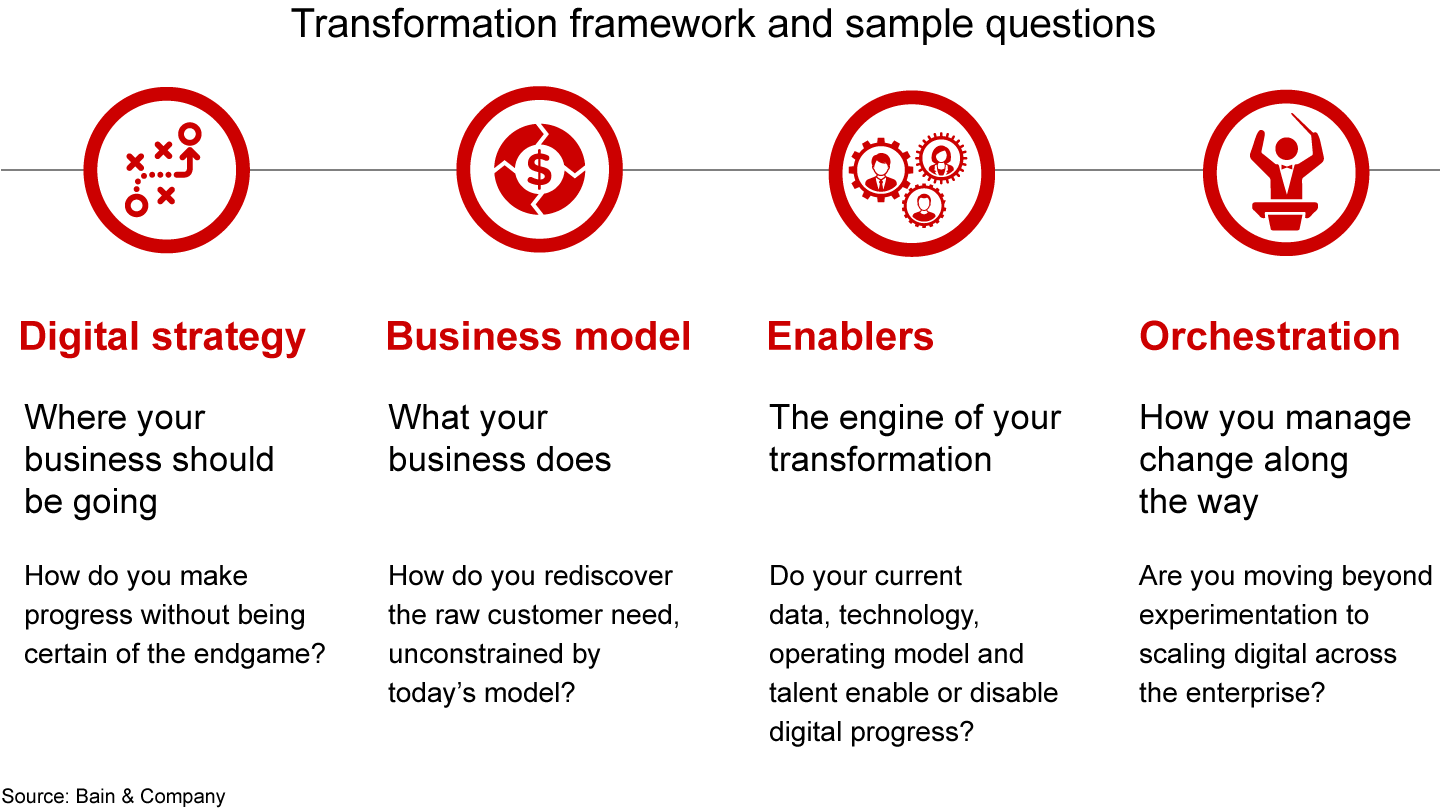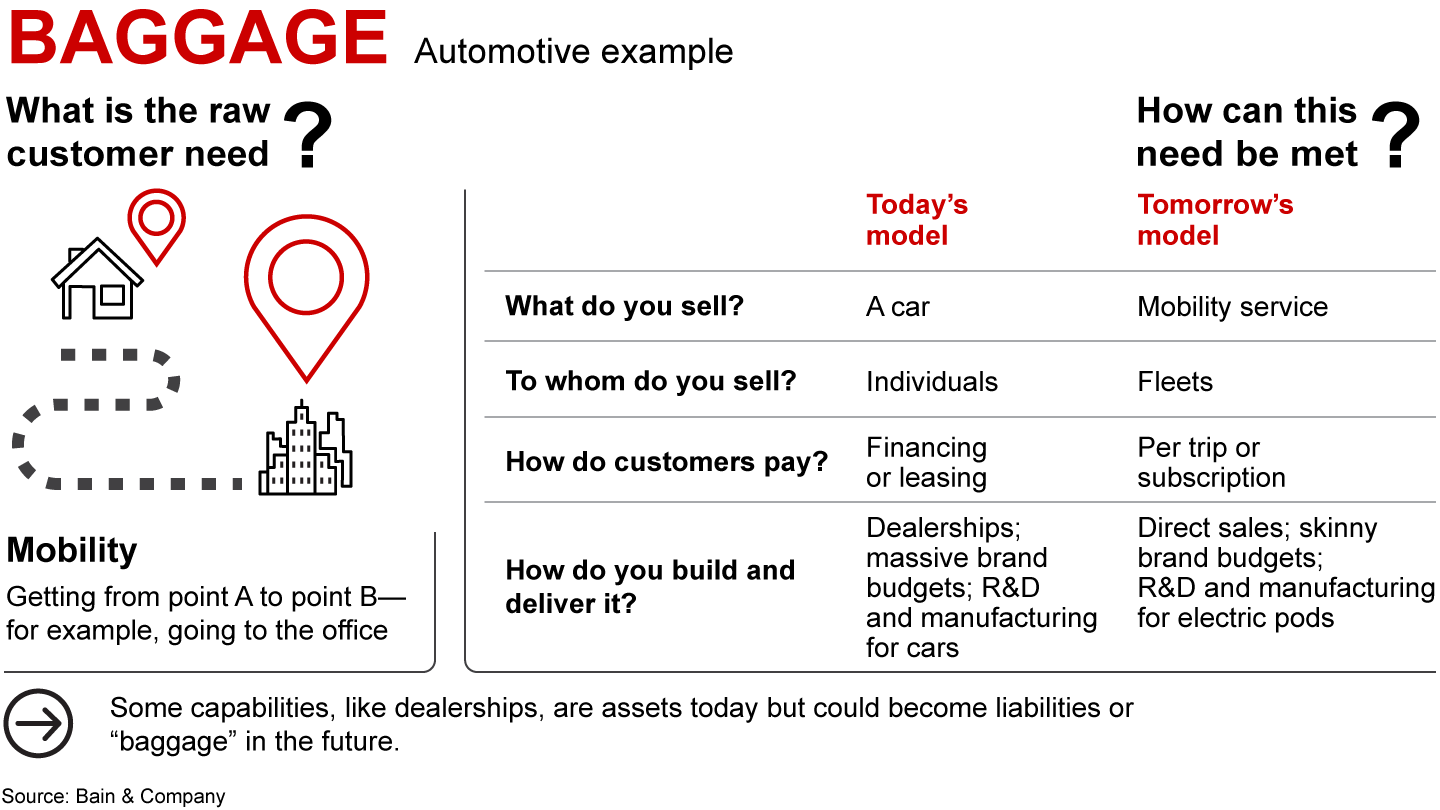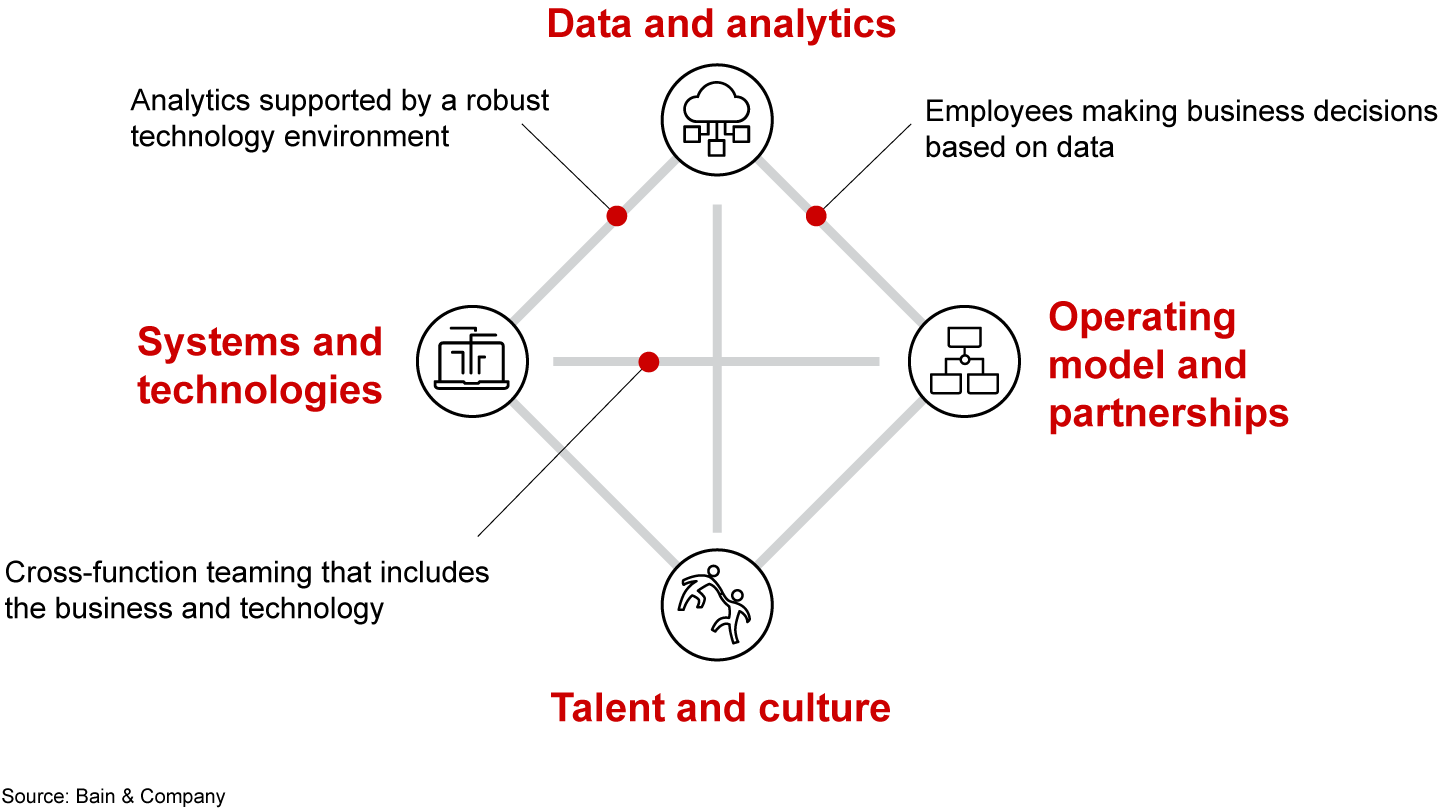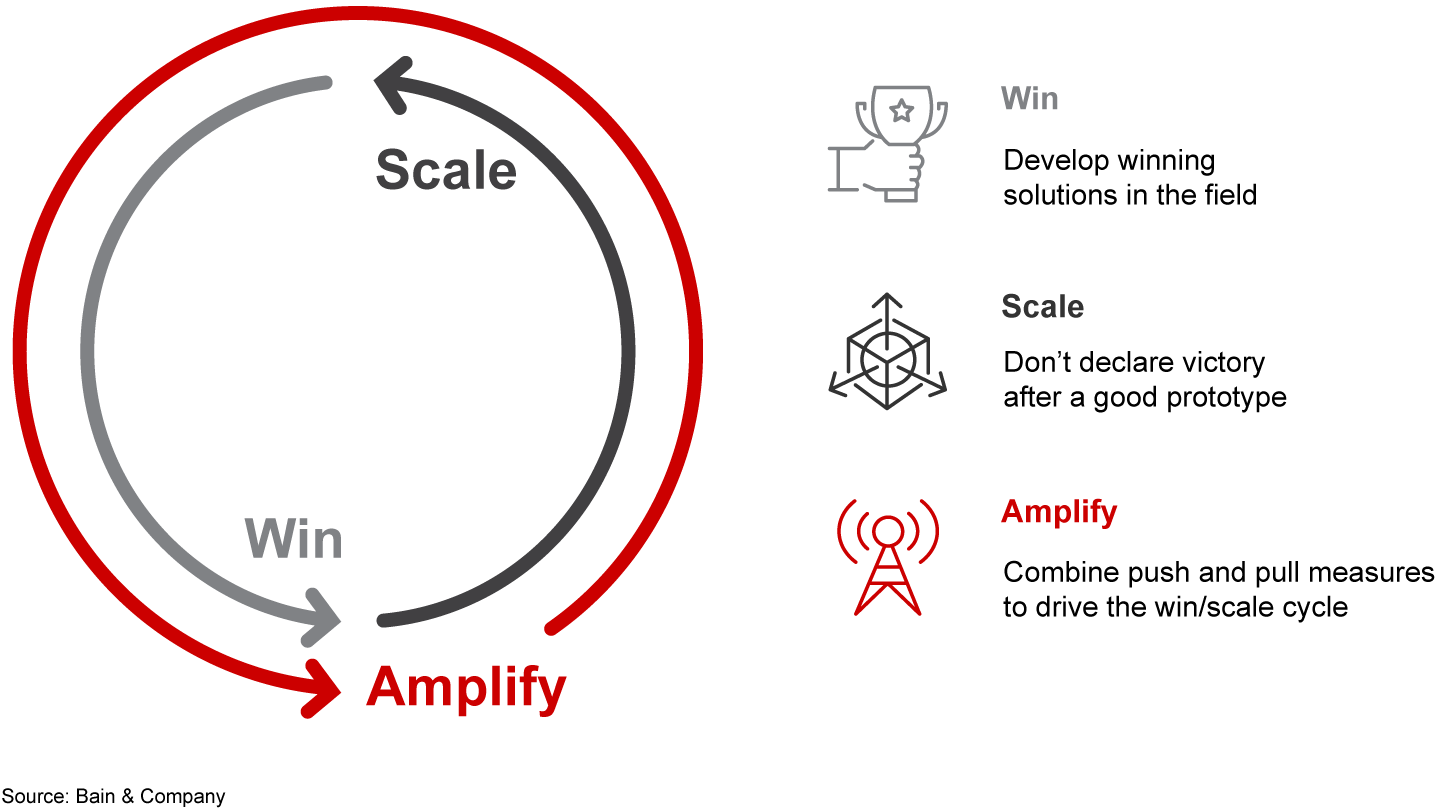Brief
 }
}
Don’t be fooled by the term “digital transformation.” The profound changes that business leaders live with day in and day out are made possible by digital technology. But just as important are the surprising and unexpected ways that people interact with technology. Recognizing that provides clarity and focus, and highlights the need to get technologists and experts with deep customer empathy in the same room, working on the same problems. Digital transformation is technology and people, innovation and disruption, offense and defense in equal measures.
Look, for example, at the rapid global spread of ride hailing. Digital technology made it possible for Uber and Didi Chuxing to match riders with drivers efficiently, inexpensively and on a massive scale. But it was customers’ embrace of the service, their willingness to jump into the cars of total strangers, that enabled those companies to redefine transportation. Similarly, Airbnb wouldn’t have been valued at $31 billion just nine years after its founding if customers hadn’t quickly become comfortable sleeping in someone else’s bed. In retail, the willingness of consumers to trust the product reviews of 1,000 online strangers, and write paragraphs of detailed description of their own, moved e-commerce from a digitized catalog to a true substitute for the trusted shop owner.
For business leaders, part of the challenge lies in the fact that the 10 to 15 major enabling technologies are very different from one another—Internet of Things, artificial intelligence, augmented reality, each has different applications and impact across different sectors of the economy. That adds complexity and fuels some of the frustration at the top of companies. It also creates real risks of many false starts and half measures chasing after “disruption,” especially because there’s no comprehensive playbook for building a digital enterprise.
To fill that gap and help executives envision, structure and sequence a successful digital transformation, Bain partnered with the World Economic Forum to convene a group of senior executives from 40 global companies. The group, all engaged in digital transformations at their companies, represent businesses from a cross-section of industries and include both incumbents and digital leaders. One year of discussion, debate and experience sharing helped to shape a framework for digital transformation that focuses leadership teams on four critical elements (see Figure 1): digital strategy, business model, enablers and orchestration.

Each company has its own distinctive way to integrate these four elements into its business. And like everything digital, the framework evolves in order to remain relevant, practical and forward-looking. Still, these elements provide valuable structure to what has been a chaotic and even damaging swirl of activities for many businesses trying to adapt.
While the current pace of change is fast, it’s probably the slowest we’ll experience for the balance of our lifetimes and careers. What company can afford not to work on digital transformation now?

Digital Transformation Roadmap: Digital Strategy
What role your company will play in the digital future.
Digital strategy: Today forward and future back
Not long ago, it would have been wishful thinking to imagine that a start-up could create a running shoe to compete against the retail presence and manufacturing power of a giant like Adidas. Today brands such as Allbirds shoes and Bonobos menswear, with few if any of the industry leaders’ conventional assets, have quickly become fashion leaders using viral marketing and direct sales to consumers. With the old rules being rewritten, every company, leadership team and board of directors feels the pressure to answer this question: How do we make progress when we don’t know the endgame?
Two big ideas are helping companies as they race to develop the components of a winning digital strategy. The first idea is to envision the business both today forward and future back. Today forward uses existing digital technology and management approaches to make a business better, faster and cheaper right now. What are the three to five focused, well-defined initiatives that can get the firm moving in the direction of its future? Every organization has its dreamers and doers, and today forward is the path of the doers. Future back is the opposite: imagining the future and then working on the steps required to position a company to compete in 10 or 20 years, including how to make progress today in order to make that happen. Future back is the domain of the dreamers. Companies need to, in effect, build a faster horse while simultaneously imagining the car.
Consider the journey of Bosch, a technology and systems supplier to the automotive industry. The company has launched a series of today forward innovations over several years that have moved Bosch in the direction of autonomous driving, its future back, while helping the company to make money along the way. Today Bosch is a respected leader in the field. An early step occurred years ago, when Bosch began producing automotive sensors that would measure a car’s acceleration. Later, it tied the sensors to antilock braking systems. In time, sensors were added to a car’s rear bumper, as well, causing a warning light to appear on the side mirrors if another car entered the driver’s blind spot. The combination of these and other technologies moved Bosch purposefully toward autonomous driving systems, including a strategic partnership with Daimler, parent company of Mercedes-Benz.
Ouriel Lancry, who coleads Bain's Global Digital practice, explains the four pillars of digital transformation—digital strategy, business model, enablers and orchestration.
Clearly, a winning digital strategy requires both today forward and future back planning. Combined, they convey a sense of long-term direction to employees and other stakeholders, while at the same time articulating the first steps the organization can take to start moving in that general direction. This isn’t a set-it-and-forget-it strategy. New information, experience and technology will change that 10- and 20-year future many times before it arrives. Flexibility is key.
The second big idea is using waves and stepping-stones to create and communicate a roadmap for the business’s future. Waves are the successive evolutions that lead a business toward the future it envisions. Stepping-stones don’t mean making progress one step at a time. Rather, stepping-stones are meant to convey the idea that you don’t see step two until you take step one. The key is moving forward but pivoting as needed, and then moving forward again. This nimble approach is challenging for many incumbent companies—but it’s at the heart of how digital natives build winning positions.
If this sounds daunting, remember how Uber launched—not as a ride-hailing pioneer, but as an on-demand black-car app, a relatively simple idea. It was only after Uber had its platform in place that the company could connect to a large group of drivers sitting in their cars. Subsequent waves of innovation enabled drivers to use their own cars, offer UberPOOL ride sharing and, most recently, experiment with self-driving cars.


Digital Transformation Roadmap: Business Model
How you engage your customers, make money and operate in the future.
Business model: Rediscover the raw need, freed from today’s baggage
Strategy is foundational, but it cannot be taken to market. Companies need a business model that takes full advantage of digital innovation and protects against digital disruption, covering customer and channel engagement, products and services, economic model and operations.
The most powerful way to unleash innovation in those parts of the business is rediscovering the raw need the business is here to serve. Many organizations fall in love with their products, which is natural and understandable. But a product, no matter how great, is really just the temporary answer to the raw need that a business serves. Raw need is the essence of what a customer values, independent of how the need is addressed today. Many incumbents started with a unique insight or model for meeting the raw customer need at one point, but over time they built up baggage that obscures that need and exposes them to disruption.
The distinction between product and raw need is important. The CEO of Domino’s, the fast food company, has said he wants customers to be able to order pizza while waiting at a traffic light—pointing to the possibility that convenience and speed matter as much as the actual pizza. Uber has described its mission as “transportation as reliable as running water.” That forces car companies to consider whether basic transportation—getting from point A to point B as easily as possible—matters more to some customers than owning a vehicle (see Figure 2).

Innovators have a knack for articulating this need and building their businesses around it. Unencumbered by a set of legacy assets and capabilities holding them back, they zero in on creative solutions that wow customers. With a whole new breed of competitors rediscovering your customer’s raw need and creating innovative ways to address it, companies must get comfortable with a challenging idea: The customer experience you deliver in the future may be quite different from the one you provide today.
That’s the Netflix story. The raw need of Netflix customers is finding entertainment they love, whether it arrived in their mailbox as a DVD or on their smartphone, from the Disney archives or fresh from Netflix studios. Focused on meeting that need, the company has changed nearly every aspect of its business model as it evolved. Originally a pay-per-DVD-rental operation, today it sells monthly subscriptions. The fulfillment expertise required to distribute DVDs by mail from large warehouses across the country has given way to investment in streaming infrastructure. From a distributor of other company’s products, Netflix has evolved into a producer of entertainment, spending billions of dollars each year to create shows and movies designed to meet the viewing patterns and tastes of its more than 130 million members.
For those looking to reconnect with their own customers’ raw need, consider a simple exercise. Ask yourself four questions: What is our product? Who buys it? How do we sell it? And how do we make it? The answers should shed light on both the customer need and the baggage making it hard to serve.
If you’re an automaker, this exercise points to a very different business model. For a century, you’ve been investing R&D into making machines aimed at firing the imagination of personal car owners. Cars will still be around, of course, but the biggest customers will be fleets, not individuals. Original equipment manufacturer (OEM) brand budgets may shrink dramatically and R&D will need to focus on different priorities—autonomous and electric, but also transportation as a service.


Digital Transformation Roadmap: Enablers
What new technologies, capabilities, skills and culture are central to success.
Enablers: The engine of your transformation
Assembling the capabilities required to power a digital transformation is often overlooked, but it’s important. Four capabilities, what we call enablers, become the engine of a successful digital transformation. Data and analytics inform critical decision making. Systems and technology are employed to get things done, and are so central that questions about them need to be solved at the CEO level, addressed alongside the strategic issues facing the business. Talent and culture, the people inputs, remain as important as ever. And the operating model and partnerships determine how all of this is put together.
Just as companies are transforming, these enablers are too. In the past, data and analytics often focused on retrospective analysis targeted at limited parts of a business. Today, they inform decisions throughout the organization, with predictive and prescriptive analysis that point to new opportunities. Similarly, while technology was once a back-office function operating in a silo, it’s now embedded in every facet of an organization. Companies often opted out of partnerships in favor of focusing inside their own four walls. Today, no company can act on its own, and success requires building an ecosystem of partnerships. In talent and culture, too, new dimensions are emerging. The old model of employment—a lifelong career spent developing deep expertise in a single function—has started to give way to a new model, focused on cross-functional skills and agile deployment.

Building a Workforce for Digital
Increasingly, companies must understand that the needs of employees are not all the same.
Working together (see Figure 3), these enablers help a company achieve full digital potential. In concert, the four can radically accelerate a transformation by, among other things, forming teams that bridge technology and operations and integrating data and analytics into operations to arm managers at all levels with data relevant to everyday decisions.

Two broad issues that executives are debating in the context of powering a transformation are, first, how to set the right data strategy and, second, how to organize for digital.
Data strategy starts not with data, but with value. A complex machine can produce many petabytes of data, but too many companies install sensors everywhere before asking themselves how to monetize the information they’re collecting. That’s actually risky. Sensors you don’t need can end up as failure points. A better starting point is to flip the sequence: What are the questions that matter to your business? Then where do you need to put systems and collection points in order to gather that data? Companies all over the world are trying to hire data scientists. But many companies still struggle to define what problems or decisions they’re going to address with their analytics. It starts with the business need.
Ouriel Lancry discusses how businesses can identify the moment they reach a sufficient amount of clarity around their digital agenda.
Landing the right operating model for digital is one of the toughest challenges for many companies. Clarity comes from defining digital at the right level. Some companies have their heads way up in the clouds, while others are down in the weeds. The key is finding the right altitude. One company that got it right is a large global vehicle manufacturer. This company’s CEO prefers to avoid using the term “digital,” but instead focuses on three words: automation, connectivity and electromobility. The company has established centers of excellence that help each of its business units translate those themes into clear strategic priorities, relevant for their organizations. Connectivity, for example, goes well beyond the vehicle, to include the driver, the dealers and their OEM partners. The whole supply chain is connected. Each center cuts across the company’s many brands and helps each business create its own strategy. With electromobility, for example, all resulting plans involve electric vehicles, but each is tailored to a particular customer base.
It’s rare to find a CEO who can spell out the company’s digital approach so succinctly, but it’s a worthy goal for any leader to have the company's digital strategy so fine-tuned that it can be explained in three words.


Digital Transformation Roadmap: Orchestration
What you need to scale from experimentation to full transformation.
Orchestration: Experimentation is easy; transformation is hard
Companies have always had to get things done. But in the same way digital technology changes how companies approach strategy, it also changes how they transform. Working on a plan isn’t enough to deliver change at the scale and speed required. The leading companies embed flexibility in their plans so they can pivot when necessary, and create the conditions that enable their front line to take charge of the digital agenda, without losing control.
Orchestration includes five critical components. Scaling breaks initiatives down into component parts and creates well-structured teams to take charge of change at the front line and integrate the groups that will enable it. Governance, metrics and risk management sets clear guardrails within which the front lines are free to innovate, and promotes change by focusing on metrics that gauge achievement, such as measurable customer value, not simple proofs of concept. It usually requires a governance structure that involves senior leaders who accelerate decision making and support scaling across the organization. Leadership focuses on aligning on a clear vision and cultivating a better understanding of technology and the “art of the possible” at all levels to build a critical mass of engagement, while making sure change actually takes place at the front line. Effective funding and investor management builds an investment case for digital change both internally and externally. It ensures internal funds shift from old business to new activities, and manages the implications of those changes. And finally, companies benefit from taking a proactive and positive approach to regulatory and community engagement.
Scaling should be a power alley for incumbents, but it presents some unique challenges. Digital projects always start with experimentation. Usually that comes in the form of contained initiatives with dedicated funding, top talent and strong leadership support. In these hothouse conditions, many digital innovations succeed. The challenge comes when a company then tries to replicate those results throughout the enterprise.
One way that companies can focus on their biggest strategic priorities and develop scalable solutions is through micro-battles, discrete time-boxed initiatives that rapidly bring strategic choices to action. Bain Micro-battles System℠ creates microcosms of the company you want to become—or become again—then scales them across your organization. Central to this method is the cycle of win-scale-amplify (see Figure 4).

Win and scale
Companies that scale effectively have a knack for turning their vision into a backlog of discrete initiatives. These steps are small enough to permit short cycles of testing and collection of customer feedback. Critically, they’re also of real potential value for the customer and the company.
Successful projects obsess about scaling issues from Day 1. They’re tested in an environment that permits the identification and resolution of critical failure points. You can think of these testing environments as “units of transformation.” They provide opportunities to experiment, but in ways that can be replicated broadly.
The best unit of transformation will vary based on the business. For a retailer, it may be the individual store; for a consumer products company, a specific brand; for a service provider, a customer episode. The units often have a profit-and-loss statement associated with them, which is important for measuring the financial impact of the experiment. Real-world experience and data collected during deployment help refine the model, feeding into a playbook for the broader rollout.
In addition to units of transformation, companies use Agile principles to foster innovation, cross-functional collaboration and risk taking. Culled from software engineering, Agile principles break initiatives into small, incremental steps. One company using an Agile approach is streaming music company Spotify, which implements new functionalities in its recommendation engine in bite-sized releases, testing them first with a subset of users. Once proven with that group, the features roll out to the broader customer base.
The same logic applies to goods and services in the physical world, but requires focus and discipline to make an Agile approach work across multiple locations, product lines or business units. It may initially bear higher frictional costs and suffer from delayed feedback loops as well, depending on the organization’s complexity.
Ouriel Lancry discusses the value of rediscovering customers' raw need to unleash true innovation.
Amplify
The role of the leadership team is to amplify the transformation. Concurrently executing multiple micro-battles accelerates the pace of the transformation and increases the chances of success. The effort works best when managed dynamically by the leadership team: Empowering individuals, spotting patterns, sharing lessons across teams, shifting resources to support winners as their success becomes clear through data and experience, skipping ahead when better versions of a given unit test successfully and, critically, pivoting or shutting down trials when they fail. As the transformation starts to have impact, it will accelerate across the enterprise. More parts of the organization will see the success and get involved.
Sometimes that requires a push, as it did recently at a large European company that had developed a new tool for its corporate food service customers to manage reservations at their restaurants. Customer feedback was positive, but uptake was low in the year following launch. By breaking the problem down into smaller pieces, management realized that the key to scaling was to build the training, marketing material and sales approach to distribute the product. After testing and learning from a pilot region in Paris, the winning proposition scaled throughout France. The leadership team amplified the wider scaling by creating a central team that worked with and trained teams in other countries for the global rollout, and secured commitment from individual country CEOs by making deployment of the digital solution one of the key performance indicators tracked by each region.

Conclusion
Real digital transformation goes deep and sounds daunting, but it can be done—digital natives and incumbents both are making it happen. Bain Radar 360SM is helping leadership teams to focus their efforts and investments, enabling companies to play offense with innovation and defend against disruption with a radically new approach to strategy that defines what you can do with digital today and how it will shape your advantage years from now.
This paper is only a starting point. We are continuously asking new questions about digital transformation—different questions and, we hope, better questions. Undoubtedly, all of you are too. What has digital transformation meant at your company? What lessons would you offer to others?

Digital Readiness Survey
This mini version of the Bain Radar 360 Strategy GPS diagnostic provides a quick snapshot of your digital readiness and guides you on next steps.
Bain Micro-battles System℠ and Bain Radar 360SM are registered service marks of Bain & Company, Inc.






